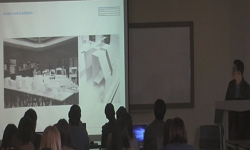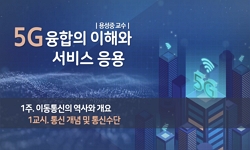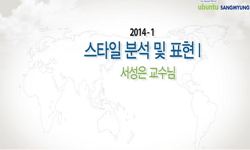(연구배경 및 목적) 세계는 도시화로 인하여 자원 및 인프라 부족, 교통혼잡, 에너지 부족 등 각종 도시문제가 심화되고 있다. 이에 따라 도시 문제의 해결을 위한 방법으로 스마트도시가 빠...
http://chineseinput.net/에서 pinyin(병음)방식으로 중국어를 변환할 수 있습니다.
변환된 중국어를 복사하여 사용하시면 됩니다.
- 中文 을 입력하시려면 zhongwen을 입력하시고 space를누르시면됩니다.
- 北京 을 입력하시려면 beijing을 입력하시고 space를 누르시면 됩니다.

스마트도시 구축에 필요한 공공공간 디자인 요소 분석 연구 = A Study on the Analysis of the Design Factors of Public Spaces for Smart Cities
한글로보기https://www.riss.kr/link?id=A105465340
- 저자
- 발행기관
- 학술지명
- 권호사항
-
발행연도
2018
-
작성언어
Korean
-
주제어
스마트도시 ; 공공공간 ; 디자인요소 ; 도시디자인 ; 공간디자인 ; Smart City ; Public Space ; Design Elements ; Urban Design ; Space Design
-
등재정보
KCI등재
-
자료형태
학술저널
- 발행기관 URL
-
수록면
71-79(9쪽)
-
KCI 피인용횟수
3
- DOI식별코드
- 제공처
-
0
상세조회 -
0
다운로드
부가정보
국문 초록 (Abstract)
(연구배경 및 목적) 세계는 도시화로 인하여 자원 및 인프라 부족, 교통혼잡, 에너지 부족 등 각종 도시문제가 심화되고 있다. 이에 따라 도시 문제의 해결을 위한 방법으로 스마트도시가 빠르게 확산되고 있다. 스마트도시는 정보통신 및 기술의 발전 4차 산업혁명 도래에 따른 시대적 화두와 맞물려 도시혁신의 새로운 모델로 증가하는 도시개발 수요를 바탕으로 각국에서 경쟁적으로 추진되고 있다. 정부에서도 ICT 기술을 활용, 도시문제를 해결하고 교통, 에너지, 환경 등 파급효과가 큰 미래 성장동력으로 스마트도시 정책을 추진하고 있다. 따라서 본 연구는 스마트도시 개발 시 공공공간에 필요한 디자인 요소를 파악하여 종합도시 계획 개념에 공공공간의 디자인 요소 적용이 초기에 적용될 수 있도록 하는데 의의가 있다. (연구방법) 본 연구에서는 스마트도시의 개념을 제시하고, 선행연구를 통해 도시디자인 및 공공공간, 공공디자인의 특성과 개념에 대해 이론적으로 고찰한다. 문헌조사를 통해 공공공간에 필요한 디자인 요소를 추출하였다. 선행연구를 통한 28개의 디자인 요소를 범주화하기 위하여 다차원 척도법(Multi dimensional Scaling , MDS)을 선정, 28개의 디자인요소의 유사성에 대하여 전문가 설문을 진행하였다. 설문조사 후 수집된 데이터를 SPSS 20.0 통계 패키지 프로그램에 코딩하여 다차원척도분석(MDS)을 실시하였다. (결과) MDS 분석 결과 각 좌표에 따라 분류된 그래프를 살펴보면, 5개의 그룹으로 유사성이 군집되는 것을 확인하였다. 5개로 범주화된 스마트도시의 공공공간 디자인요소는 안락성, 심미성, 역사성, 정책성, 경제성으로 정의하였다. 디자인은 사회전반에서 점점 중요시 되고 있으며 스마트도시 구축시 도시설계 단계에서부터 디자인 요소가 접근되어야한다. 또한 스마트 기반시설(스마트 에너지, 도로, 자원 재순환 등) 구축 시 위에서 분석된 디자인 요인을 바탕으로 스마트도시 구축 시 공공공간의 설계에 반영, 도시기능을 효율화하고 도시 문제를 해결하는데 활용되어야 할 것이다. (결론) 스마트도시는 기술을 기반으로 하고 있지만 도시공간을 이용하는 시민들이 접하게 되는 공간으로서 디자인 적용이 필수적으로 필요하다. 신정부는 스마트코리아를 추진하기 위하여 스마트도시 구축에 전력을 기울이고 있다. 이에 에너지, 교통, ICT등의 인프라 구축 또는 법·제도적 측면에서 디자인요소가 고려되어야 할 것이다. 기획, 설계, 운영, 관리의 통합적 도시개발 과정에서 디자인을 필요조건으로 인식하고. 본 연구를 바탕으로 향후 스마트도시 구축 단계에서 공공공간 영역이 공간·기술·주체별 맞춤형 전략 방안을 디자인적 접근을 통하여 모색 하고자한다.
다국어 초록 (Multilingual Abstract)
(Background and Purpose) As a result of urbanization, the world is becoming increasingly troubled by urban issues, such as lack of resources and infrastructure, congestion, and energy shortages. Accordingly, smart cities are increasingly being seen as...
(Background and Purpose) As a result of urbanization, the world is becoming increasingly troubled by urban issues, such as lack of resources and infrastructure, congestion, and energy shortages. Accordingly, smart cities are increasingly being seen as a way to solve urban problems. Smart cities are competitively driven by the demand for urban development, which is a new model for urban innovation combined with the trend of the fourth industrial revolution. The government is also promoting smart city policies as future growth engines that will utilize ICT technology, solve city problems, and have a ripple effect on transportation, energy, and the environment. Accordingly, this study is significant in identifying design elements necessary for public spaces in smart city development so that the application of said design elements in public spaces can be initially applied to the general urban planning concept. (Method) In this study, concepts from smart cities are presented, and prior studies are used to explore the characteristics and concepts of urban design, public spaces and public design in a theoretical manner. From the literature review, the design elements required for public spaces were identified. To categorize 28 design elements from a prior study, the Multidimensional Scaling (MDS) method was selected, and its similarity to 28 design elements was explored. Data collected after the survey was coded into a SPSS 20.0 Statistical Package Program to carry out a MDS analysis. (Results) Based on the MDS analysis results, the graph grouped according to the respective coordinates was examined, revealing that the similarity could be organized into five groups. The five public space design elements of smart cities are comfort, aesthetics, historicity, restativeness, and economy. Design is becoming increasingly important across society, and design elements should be approached from the urban design phase in smart city deployments. In addition, smart infrastructure (smart energy, roads, resource recirculation, etc.) should be implemented to efficiently reflect on the design of the public spaces and to solve urban problems when constructing smart cities based on the design factors analyzed above. (Conclusions) Smart cities are based on technology, but design applications are essential as the spaces where citizens using urban spaces come into contact. The new government is making a concerted effort to build smart cities for a smart Korea. Accordingly, design elements should be considered in terms of infrastructure construction, including energy, transport and ICT, as well as legal and institutional aspects. Design is recognized as a necessary condition in the integrated urban development process of planning, design, operation, and management. Based on this research, we intend to seek a customized strategic plan for each spatiality, technology, and principals across all phases of smart city development.
참고문헌 (Reference)
1 김혜란, "지구단위계획내 특별계획구역에 대한 공공공간의 공공성 평가" 한양대학교 도시대학원 2014
2 권영재, "장소기억기반 공간재생에관한 연구 : 서울시 미래유산을 중심으로" 홍익대학교대학원 2016
3 서동진, "장소 정체성을 위한 도시 공공공간 유형 연구" 한국공간디자인학회 11 (11): 89-99, 2016
4 허진하, "이용자 만족도를 위한 공공영역의 디자인 평가 방법에 관한 연구" 단국대학교 대학원 2012
5 임종훈, "이용자 만족도 분석을 위한 공공디자인 평가항목에 관한 연구" 한국공간디자인학회 11 (11): 101-111, 2016
6 이양숙, "시민참여 기반의공공디자인 정책 평가 체계 개발 연구" 홍익대학교 대학원 2015
7 백승경, "생태적으로 지속가능한 공공공간 디자인 체크리스트에 관한 연구" 홍익대학교 대학원 2009
8 안진근, "문화도시 정체성 형성을 위한 공공디자인 평가체계에 관한 연구" 홍익대학교 대학원 2011
9 김도경, "도시공원의 디자인 평가 지표 연구" 조선대학교 대학원 2013
10 백승경, "공공디자인에 생태적으로 지속가능한 요소와 도시적 표현에 관한 연구" 한국공간디자인학회 3 (3): 73-83, 2008
1 김혜란, "지구단위계획내 특별계획구역에 대한 공공공간의 공공성 평가" 한양대학교 도시대학원 2014
2 권영재, "장소기억기반 공간재생에관한 연구 : 서울시 미래유산을 중심으로" 홍익대학교대학원 2016
3 서동진, "장소 정체성을 위한 도시 공공공간 유형 연구" 한국공간디자인학회 11 (11): 89-99, 2016
4 허진하, "이용자 만족도를 위한 공공영역의 디자인 평가 방법에 관한 연구" 단국대학교 대학원 2012
5 임종훈, "이용자 만족도 분석을 위한 공공디자인 평가항목에 관한 연구" 한국공간디자인학회 11 (11): 101-111, 2016
6 이양숙, "시민참여 기반의공공디자인 정책 평가 체계 개발 연구" 홍익대학교 대학원 2015
7 백승경, "생태적으로 지속가능한 공공공간 디자인 체크리스트에 관한 연구" 홍익대학교 대학원 2009
8 안진근, "문화도시 정체성 형성을 위한 공공디자인 평가체계에 관한 연구" 홍익대학교 대학원 2011
9 김도경, "도시공원의 디자인 평가 지표 연구" 조선대학교 대학원 2013
10 백승경, "공공디자인에 생태적으로 지속가능한 요소와 도시적 표현에 관한 연구" 한국공간디자인학회 3 (3): 73-83, 2008
11 김지현, "가치기반 공간디자인 마케팅에 관한연구" 홍익대학교 대학원 2016
12 Kang, Hyun-joo, "Culturally minded Public design business Evaluation Indicator Reports" KCDF 2010
동일학술지(권/호) 다른 논문
-
전시 프로그램 개발에 의한 한국기계연구원 전시 공간디자인에 관한 연구
- 한국공간디자인학회
- 신동준 ( Dongjun Shin )
- 2018
- KCI등재
-
교육적 체험 프로그램을 적용한 교육박물관 디자인에 관한 연구
- 한국공간디자인학회
- 신동준 ( Dongjun Shin )
- 2018
- KCI등재
-
- 한국공간디자인학회
- 김원길 ( Wongil Kim )
- 2018
- KCI등재
-
- 한국공간디자인학회
- 권다영 ( Dayoung Kwon )
- 2018
- KCI등재
분석정보
인용정보 인용지수 설명보기
학술지 이력
| 연월일 | 이력구분 | 이력상세 | 등재구분 |
|---|---|---|---|
| 2022 | 평가예정 | 재인증평가 신청대상 (재인증) | |
| 2019-01-01 | 평가 | 등재학술지 유지 (계속평가) |  |
| 2016-01-01 | 평가 | 등재학술지 선정 (계속평가) |  |
| 2015-06-01 | 학술지명변경 | 외국어명 : Journal of the Korea Intitute of the spatial design -> Journal of Korea Intitute of Spatial Design |  |
| 2015-01-01 | 평가 | 등재후보학술지 유지 (계속평가) |  |
| 2013-01-01 | 평가 | 등재후보 1차 FAIL (등재후보1차) |  |
| 2012-01-01 | 평가 | 등재후보학술지 유지 (기타) |  |
| 2011-01-01 | 평가 | 등재후보 1차 PASS (등재후보1차) |  |
| 2009-01-01 | 평가 | 등재후보학술지 선정 (신규평가) |  |
학술지 인용정보
| 기준연도 | WOS-KCI 통합IF(2년) | KCIF(2년) | KCIF(3년) |
|---|---|---|---|
| 2016 | 0.47 | 0.47 | 0.53 |
| KCIF(4년) | KCIF(5년) | 중심성지수(3년) | 즉시성지수 |
| 0.51 | 0.52 | 0.692 | 0.28 |





 KCI
KCI KISS
KISS






